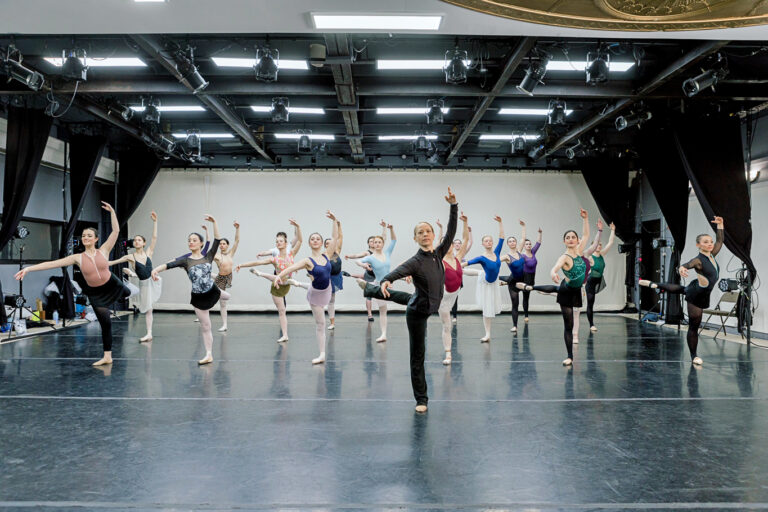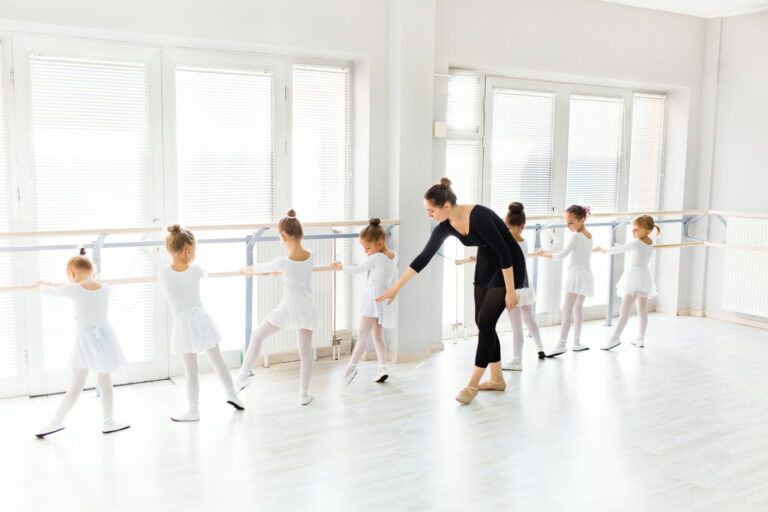Teaching dance through familiar childhood games can be a great way to enliven the routine you have already established in your beginning ballet or creative movement class and can make learning fun for young students. Many games can be adapted for the studio. Here are some ideas to help you get started and some guidelines for safe and enjoyable ways to use games in the classroom.
Before introducing any activity, develop with your students a core of simple steps such as skipping, marching or a princess (or prince) walk on demi-pointe. Then, add basic arm movements such as swan arms, salutes or swimming through the air. Practice these at the start of each class to help students memorize them.
Follow the Leader
This is a great game for grabbing students’ attention at the beginning of class and teaching simple movements. You can begin by being the leader and having everyone line up behind you. Have students pay attention to who is in front of them, and tell them to stay behind that person. For very young students, this is as much of a challenge as following your lead!
Start with a simple step that uses just the feet or just the arms. Increase difficulty as students improve. For example, begin with a march and add a salute after they have marched for a little while. You can lead the group in a big circle or a snake, and vary the pattern to keep students on their toes.
Older dancers may take turns being the leader. You can give them direction by telling them which steps to do, or let them come up with their own combinations. Change leaders often so that everyone gets a turn.
Simon Says
Using Simon Says is a good way to work on complex steps or introduce new ones, because it allows you to break down larger movements into smaller ones. Adjust the rules of the game to make it age-appropriate. Avoid hurt feelings by starting over often, rather than playing until there is a winner.
Red Light, Green Light, One, Two, Three!
Listening for directions, students move toward you when you say “green light” and stop when you call out “red light.” Your younger students can work on balance and following instructions, while older children practice ballet movements. Tailor this game to the studio setting by asking students to do a dance movement, such as standing in arabesque, when you say “red light.” You can even teach a combination, and then use it in the game for practice. Red Light, Green Light can also be played in slow motion if things get too rowdy in the classroom. One of the rules can be, if you move after the teacher says “red light,” then you have to go back to the starting point.
Red Rover
Great for creating a friendly environment in the classroom, this game is also useful for teaching students each other’s names. Naturally, you do not want to use this game with the break-through element, which can be too dangerous for dance class, but rather as a means of calling students over one at a time (or in pairs if some have short attention spans).
To begin, ask the children to line up on one side of the room, while you stand on the other. Call out, “Red rover, red rover, let Sarah come over—doing the princess walk.” Once Sarah joins you, whisper in her ear whom to call next, so that you can call the next student together. Vary the movements by choosing from your repertory of basic steps, paying attention to students’ different abilities. Pretty soon there will be a chorus of voices calling out and the class will be having a great time.
Name That Tune
This game is an effective way to teach students about dance music in any type of class. Use selections that students may hear in the future, such as The Nutcracker, Singin’ in the Rain or I Got Rhythm, depending on the discipline you teach. Older students can try to recall the steps that go with the music.
How to Keep Control
There are a few things to keep in mind, such as noise level. Children who are having a great time are usually very loud. This is not appropriate in a studio and can make it difficult to maintain a good learning environment. Sometimes, a talk beforehand about listening carefully can be helpful. Also, stay aware of the energy level in the class at all times—you can usually sense when things are getting too wild. When this happens, shift to a slow or quiet activity to settle things down.
Another consideration when using games in the classroom is the rules. All of the students should know exactly what the rules are, and they should be explained every time a game is used (See “Memory Game” on the left to find more games and their rules). Children often forget things from week to week, so you’ll want to refresh their memories.
Use your imagination to come up with games of your own, or to totally revamp games that you want to use. You can change any rules to make a particular game suited for the dance classroom; the more creative, the better. For example, you can use games for a part of your class, as a type of reward or for the full session—it’s entirely up to you.
There are many fun activities to choose from. Perhaps you like the hokey pokey, hopscotch or remember another game that you really enjoyed when you were growing up. Children love to learn the chicken dance and they look adorable doing it!
Teaching dance through games is a fun way to get your students involved and keep their attention. They will look forward to playing their favorites and get excited about learning new ones. It is also a great way to stay fresh as an instructor.
Freelance writer Catherine L. Tully teaches dance at Trinity High School in River Forest, IL, and has more than 16 years of teaching experience.



